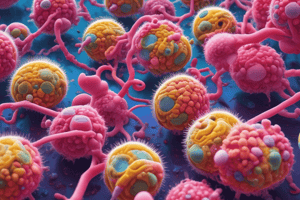Podcast
Questions and Answers
Which of the following is NOT a general characteristic of Corynebacterium?
Which of the following is NOT a general characteristic of Corynebacterium?
- Gram-positive
- Rod-shaped
- Spore-forming (correct)
- Catalase positive
Which species of Corynebacterium is responsible for causing diphtheria?
Which species of Corynebacterium is responsible for causing diphtheria?
- C.hemolyticum
- C.jeikium
- C.ulcerans
- C.diphtheriae (correct)
What is the major symptom of respiratory diphtheria?
What is the major symptom of respiratory diphtheria?
- Ulcers
- White pseudomembrane over the throat (correct)
- Pharyngitis
- Sore throat
Which stain is used to visualize the metachromatic granules in Corynebacterium?
Which stain is used to visualize the metachromatic granules in Corynebacterium?
What type of infection does C.ulcerans cause?
What type of infection does C.ulcerans cause?
Which selective media is used to differentiate commensal species from C. diphtheriae?
Which selective media is used to differentiate commensal species from C. diphtheriae?
What is the purpose of Tindsdale medium?
What is the purpose of Tindsdale medium?
What is the mainstay of treatment for Diphtheria?
What is the mainstay of treatment for Diphtheria?
Which antibiotics are sensitive for Diphtheria treatment?
Which antibiotics are sensitive for Diphtheria treatment?
Which test is used to identify C. diphtheriae through Ag-Ab interaction?
Which test is used to identify C. diphtheriae through Ag-Ab interaction?
Flashcards are hidden until you start studying
Study Notes
General Characteristics of Corynebacterium
- Gram-positive, catalase positive, non-spore-forming, non-motile, rod-shaped bacteria
- Metachromatic granules are usually present representing stored phosphate regions
- Also known as the Klebs-Löffler bacillus
- Genus has many species
- Most commensals called Diptheroids
- Human pathogens include C.diphtheriae, C.hemolyticum, C.jeikium, and C.ulcerans
Diphtheria
- Respiratory diphtheria is more serious than cutaneous diphtheria
- Organism is inhaled and exotoxin (neurotoxin) spreads via blood to other organs
- Clinical diagnosis includes the presence of a membrane in the throat
- Lab diagnosis involves microscopy and culture
Lab Diagnosis
- Microscopy: Pleomorphic gram-positive bacilli, gram variable, coryneform (Chinese letter arrangement)
- Special stain: Albert's stain (KLB stain) to stain volutin (metachromatic polyphosphate granules)
- Culture: Selective media like Hoyle's Tellurite blood agar and Tinsdale medium
Identification of Corynebacterium diphtheriae
- Biochemical tests like Hiss's Serum sugars, urease, and gelatin liquefaction
- Virulence testing includes ELEK's test and Guinea pig inoculation
Treatment and Prevention
- Mainstay of treatment is Antidiphtheritic serum (antitoxin)
- Antibiotics used for treatment of carriers and in synergy with antitoxin
- Sensitive to Erythromycin, Penicillin, and Clindamycin
- Vaccination is important to prevent diphtheria
Studying That Suits You
Use AI to generate personalized quizzes and flashcards to suit your learning preferences.




